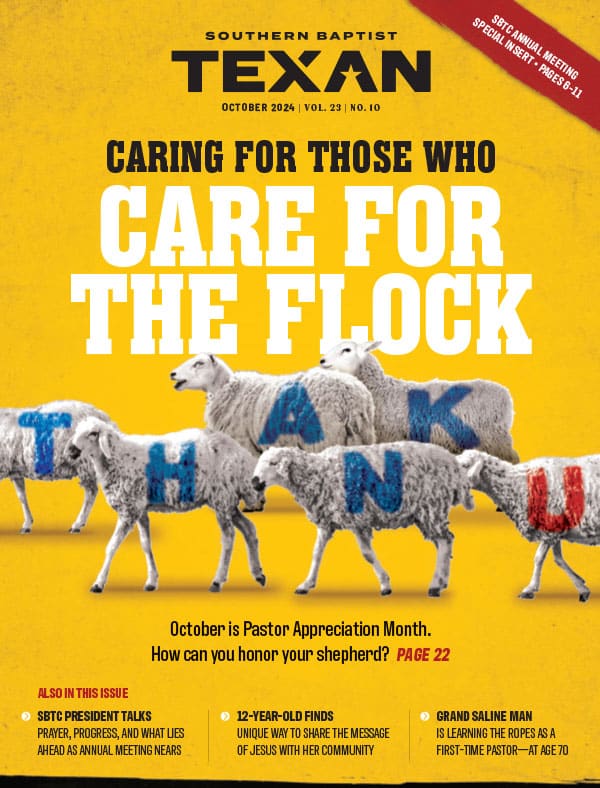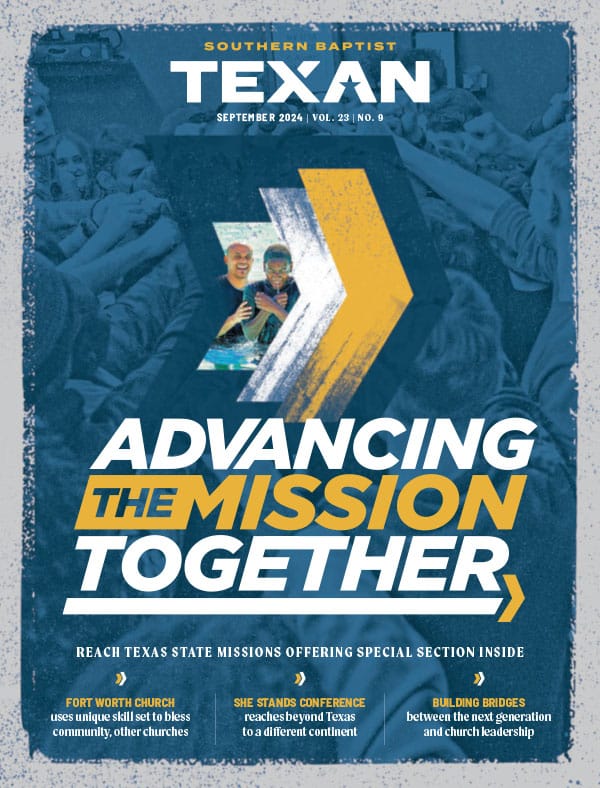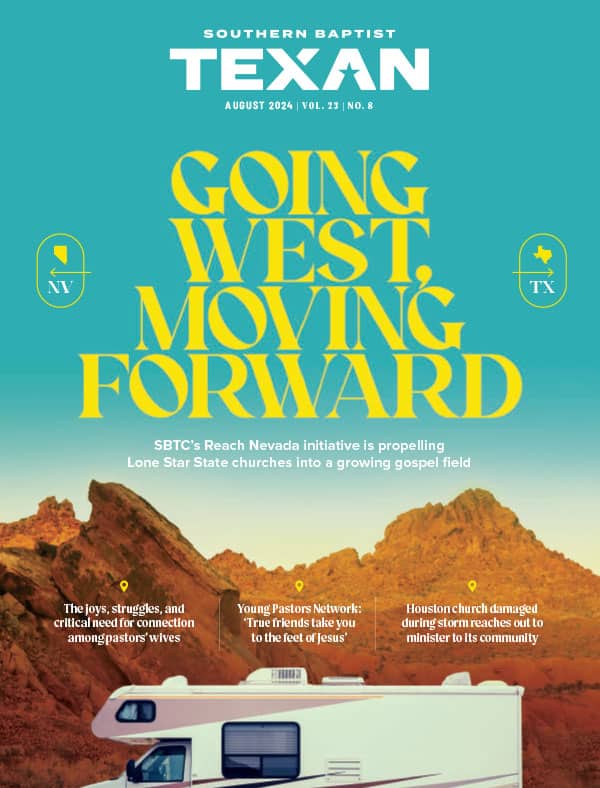FORT WORTH–Dallas Wiens sat on an old wooden church pew in his grandparents’ living room in Fort Worth, Texas, legs crossed like a gentleman scholar, spewing forth wisdom typically earned in proportion to one’s gray hairs. One year ago, he’ll tell you, he didn’t see clearly. He does today. Never mind the blindness, injuries and proverbial mountain climbing. He wouldn’t take it back if he could.
“We find ourselves through trial, turmoil and pain,” Weins said with a stubborn resolve. “You don’t see God when you are handed a million dollars. You see God when you have lost everything.”
Through it all, his relationship with his dad was renewed, and with his Heavenly Father too.
These days, his 24-year-old face is draped in skin and muscles painstakingly transplanted from his calf, thigh and back in a surgery the scale of which had not been done before at Parkland Hospital in Dallas. Wiens is a work in progress, doctors say. Word is that his burns were the worst the world-renowned Parkland Burn Service had seen in 30 years.
Last Jan. 6, plastic surgeons took the first step in restoring Wiens’ devastated facial features–the result of his coming in contact with a high-voltage electrical wire. As he approached his third month in a medically induced coma, physicians from the University of Texas Southwestern Medical Center in Dallas worked their precise craft for 17 hours, then 19 hours the next day, connecting skin grafts and muscle flaps under a microscope using thread the diameter of a human hair.
When it was over, the relocated muscles and skin were contoured around facial bones and skull, covering where Wiens’ eyes and nose once protruded. His hairline is pushed back for now. The goatee he now sports is slightly off-center, but osteo-integrated implants will fix some of those issues in future surgeries, surgeons said. His speech is remarkably clear considering his family was told early on he likely wouldn’t talk again.
“In that kind of surgery, the first 72 hours present a very touch-and-go situation,” said Stephen Matthew Becker, the plastic surgeon who along with Jeffrey Janis, Parkland’s chief of plastic surgery and director of UT Southwestern’s plastic surgery residency program, conducted Wiens’ operation. “Ten to 15 years ago, this would have been a lethal injury.”
“Dr. Janis really saw the challenge of this operation and had the foresight to say ‘you’re going to need to do this and this as well,'” Becker commented. “He didn’t back down from the challenge and has been very instrumental in coordinating a plan for Dallas’ continued care.”
Becker, now practicing in Knoxville, Tenn., after finishing his residency at UT Southwestern, said Wiens is a work in progress medically speaking, but his evident faith was the intangible that lifted him across barriers.
His former Sunday School teacher, Darla Mahan, said while sitting across from Wiens as he recounted his journey: “I wrote a letter to his parents after he left the sixth-grade class telling them that God had something special in store for Dallas. I had never written that about any of the children I had taught, and never did again. It was just obvious that God had his hands on Dallas.”
Wiens is sure of that much.
THE ACCIDENT
On Nov. 13, 2008, Wiens, his oldest brother and an uncle were finishing a painting job at his home church, Ridglea Baptist in Fort Worth, just a few blocks from the house he’d grown up in. As Wiens recalls it, one moment he was looking up at the church precipice “and not being happy that I had to repaint it” after heavy rains had washed his work away a few days earlier.
The next thing he remembers with any clarity, he lay in a bed at Parkland Hospital, immobile and unable to see or speak. It was early February.
“I don’t even remember getting in the lift that day at the church,” recalled Wiens, who grew up under the tutelage of his devout grandparents and the watchful eyes of Sunday School teachers such as Mahan, who watched him grow from 6-year-old to a headstrong young man who veered from his godly upbringing.
According to eyewitnesses, Wiens was in an aerial lift, positioning himself to finish his painting job when the lift began to move and it, or Wiens, or both, made contact with a high-voltage wire. No one knows for sure how it happened. Wiens was care-flighted to Parkland where doctors were in awe that his survived at all and convinced he wouldn’t survive longer.
Forty-eight hours later, doctors gave the family slim hope, his grandmother, Sue Peterson, said. Hours passed, then days and weeks.
Bracing for the worst, doctors told the family that Wiens would likely be paralyzed from the neck down, would never speak or produce adequate saliva to eat solid food.
His head covered in bandages from extensive surgery, Wiens recalled hearing a woman tell his family of his likely prognosis, “and I remember that I didn’t like it and wouldn’t believe it.”
“Everything they told my family I wouldn’t do, I am doing,” said Wiens, teeming with satisfaction in stunning his naysayers. He told a doctor during his stay at Parkland the same thing, and the doctor challenged him one further: “Bet you won’t do pushups.”
“I proved him wrong. I’m up to 15 pushups,” Wiens said.
“I was blessed that we live in Texas,” he remarked. “Everything’s bigger in Texas, even medical care.”
Becker, the plastic surgeon, said Parkland’s burn center has been a trailblazer; the worldwide standard in burn resuscitation is known as “The Parkland Formula.”
Wiens remarked, “The nurses at Parkland in the burn ICU and burn ACU, they hide their wings in their scrubs.”
DADDY’S HANDS
As Wiens recovered in the hospital, he asked to see his daughter, Scarlette, who was 2 at the time, but hospital staff were concerned how she might respond to her dad’s condition and appearance. Over several weeks, a child psychologist slowly exposed her to the hospital environment, gave her a nurses’ outfit, let her play near her dad’s room, and showed her photos of Wiens.
When the time came, the family and the child psychologist were uneasy. Scarlette walked into the room, seemingly ignored the bandages that covered Wiens’ face and pointed his mid-section where his hands were resting.
“Daddy’s hand!” she cried. “Daddy’s hands!”
Chocking back joyful tears, the child psychologist left the room to bawl, Peterson recounted. Scarlette never flinched.
On visits to see her daddy and her great-grandparents in Fort Worth, she will inevitably spy a photo of Wiens before the accident and respond, “That was before Daddy got his boo-boo,” Peterson said. “Is Daddy’s boo-boo getting better?”
SPIRITUAL RENEWAL
“When I woke up in the hospital, I sensed the presence of God,” Wiens said. “If you pray and you wonder if God is listening, I guarantee you that he is.”
As he puts it, losing one eye and not having use of the other for the time being, “God has really given me a gift of seeing things.” What he can’t see by sight, he can hear in the emotional nuances of another’s vocal inflection—something he would have missed before, he said.
His new way of seeing, Peterson said, results from a decade of her and Wiens’ grandfather, Del, and others from their church praying for their grandson to return to God from his season of rebellion and anger over severed relationships.
“The Word of God will not return void,” Peterson said, explaining why she played the Bible on audio nearly the entire time of Wiens’ hospitalization.
As phone calls to friends, family and members at Ridglea Baptist Church were made, prayer notes and encouragement came from as far away as Germany. A women’s group at an Episcopal church in Escondido, Calif., sent a prayer quilt they had stitched for Wiens, Peterson said. “We don’t even know anyone in Escondido, Calif.”
Peterson recalled the encouragement she received from a nurse one day as she was distressed over her grandson’s condition. As Scripture played in the background, the nurse remarked, “You just keep doing what you’re doing. God has his hands on this young man.”
“As a public health nurse, she’s encouraging me to hang in there and keep trusting the Lord,” said Peterson, restraining tears as she recalled it.
WALKING AGAIN
By June after leaving the hospital, Wiens decided he would make short use of his wheelchair. By July 10, it was collecting dust in a storage shed, he said.
He went back to church last summer as well, and spends many of his days absorbing Scripture on audio. He has listened to Proverbs, Revelation, all four Gospels, Acts, Romans. One of his favorite passages is Ezekiel 37:5-6: “Thus says the Lord God to these bones: Behold I will cause breath to enter you, and you shall live. And I will lay sinews upon you, and will cause flesh to come upon you, and cover you with skin, and put breath in you, and you shall live, and you shall know that I am the Lord.”
His pastor at Ridglea Baptist, Scott Cox, said that while he had limited conversations with Dallas before the accident, the “transformation of his heart was undeniable. In talking to Dallas just months subsequent to the injury, it was like talking to someone who had been walking with Lord for years. There was a real wisdom and depth to his experience with Christ, which was evident in our conversations. It was like he had a crash course in Jesus.”
Said Becker: “I think faith plays an important role in my taking care of him as well. Parkland is a very demanding program. You get a patient like Dallas and you realize maybe that’s why you’ve gone through the difficulty—so that you would be there, exactly where you were intended to be, as the right person to take care of that patient.
“Any challenge presented before him he will meet and exceed the expectations. That’s just a drive that comes from believing that God has bigger plans for him.”
A donor has left an upper and lower eyelid for Wiens’ remaining eye, to which doctors believe they can restore sight after a surgery to open the flap covering the eye. Wiens and the Petersons are praying the procedure will occur soon. Meanwhile, Wiens is busy inspiring his grandmother and others who cross his path.
Mahan, his childhood Sunday School teacher, told Wiens, “I came here last summer hoping to encourage you, and you were the one who lifted me up. Do you remember that?”
Wiens remarked: “If you can’t laugh at life, then there’s no reason to live. There’s a difference between living and surviving. Every breath I take, God is responsible for giving it and he deserves the praise and the glory.”
“After the accident,” Peterson said, “Del and I really prayed that God would allow him to live and would use this as a transformation point in his life. He really has. Every day is a new day with Dallas, and we are so grateful.”
Wiens doesn’t qualify for Medicare or Medicaid, so one of his goals is to raise money for his future surgeries, and for the surgeries of others like him.
“God is still unfolding everything in his time, and it will be OK,” Peterson said.










